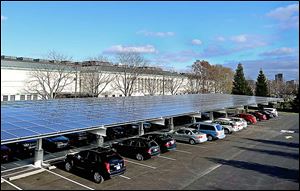
Fueling savings at art museum happiest when skies are sunny
Solar panels help create excess power power to grid
6/8/2013
The solar canopy in the Toledo Museum of Art parking lot is in addition to panels on the roof. Along with energy-efficiency measures, they helped the museum create excess power two days.
The Toledo Museum of Art is hoping for more sunny days.
At least twice this spring, the museum’s main building stopped pulling power from the electrical grid because it had enough from on-site renewable energy sources, including solar panels, officials said.
The museum took its first steps toward greater energy efficiency in the early 1990s, and in the years since continued to focus on energy-saving measures and renewable sources.
The museum has six microturbines powered by natural gas.
Solar panels went up on the roof in two phases beginning in 2008. And, in October, it completed a parking lot project with a solar canopy. The result is about 500 kilowatts of solar energy production, said Carol Bintz, the museum’s chief operating officer.
Generation combined with efficiency efforts allowed the museum’s main building to stop drawing power from the grid on a portion of both May 21 and Wednesday, which were sunny days, Ms. Bintz said. For part of the May day, the museum returned power to the system, which results in a credit on its bill through a net metering agreement, she said.
“As a private museum, it’s essential for us to make the best use possible of our resources,” said Director Brian Kennedy, adding that using sustainable energy and running the museum “in such an efficient way” is “really pleasing.”
Ms. Bintz said she did not know how many days a year the museum might be able to power the building without using the grid but said the recent activity demonstrates it is possible on sunny days.
“It is all a bit of a balancing act,” she said, adding that multiple factors contribute to the amount of power needed and produced. “That’s also why you can’t really separate yourself from the grid.”
The museum’s various energy efforts cut overall electrical consumption by about 80 percent since 1992, she said.
Ms. Bintz estimated those efforts have saved the museum hundreds of thousands of dollars but said it’s difficult to calculate exact savings because of rate changes and other variables. “All I know is that by reducing our consumption, we are going to reduce our costs,” she said.
Chris Eck, a FirstEnergy spokesman, wouldn’t discuss a specific customer account, including museum energy usage or the amount it might have contributed back to the grid.
He said in 2012, the utility purchased roughly 7,500 solar renewable energy certificates in Ohio through a wholesaler, including five from the museum, as part of the utility’s fulfillment of state renewable energy requirements.
Contact Vanessa McCray at: vmccray@theblade.com or 419-724-6065.